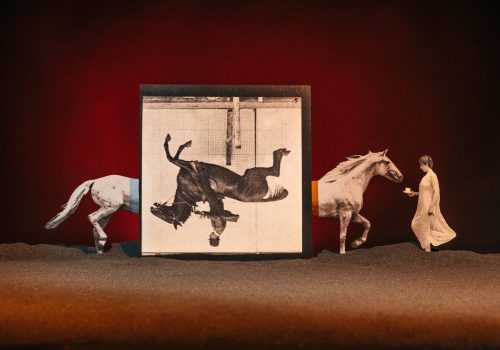Anzenberger Gallery presents a new series by Klaus Pichler : The Loco Motion – The Human Figure Off The Grid, 2019-2020
In 1887, photographer Eadweard Muybridge published an extensive portfolio entitled ‘Animal Locomotion: an Electro-Photographic Investigation of Connective Phases of Animal Movements’. The volume consists of photographs showing more than 20.000 figures of moving men, women, children, animals and birds, arranged on 781 plates. Each plate is presenting a series of ‘stills’ depicting the various stages of a complete movement in front of a standardized backdrop, making this volume a ground-breaking photography study of human and animal locomotion.
The book starts with images of male athletes in motion, representing ‘civilized’ masculinity, followed by women performing domestic tasks, then moving to photographs of disabled persons and concluding with pictures of animals. The sequence of the book can be seen as an attempt to sort the photos by grade of an idealized typology, showing distinct lines between species, gender, physical abilities and also class: most of the men had an academic background, whilst the women were recruited from less privileged conditions.
To some extent, Muybridge’s project is also informed by a racialized narrative: in 1885 he photographed Ben Bailey, the only person of color in the portfolio, in front of a black backdrop with a white grid. This so-called ‘anthropometric grid’ was invented by J. Lamprey in 1869 as a photographic measuring system to analyze the physical differences between whites and ‘the others’, following a racist ideology in times of colonialist expansion. Muybridge established this grid in American photography in 1885 and kept it for all of his further locomotive images. Therefore, the formal style and the standardized outcome of Muybridge’s photo plates can be seen as an effort of turning the living bodies of his subjects into sets of standardized, comparable and measurable data.
Obviously, it would be too easy to criticize Muybridge’s efforts, as his approach was closely intertwined with the discourses in medicine, anthropology and politics of that time. Nevertheless, it is the motivation of this project, entitled “The Loco Motion”, to create new meaning by deconstructing and reconstructing the pictures. The series is a playful attempt to re-contextualize the works of Muybridge. The starting points are the liberation of the depicted characters from the normative hegemony of the ‘anthropometric grid’ and the deconstruction of the original photographs’ strict system.
The project also contains new images without characters, which reflect on the general question of scientific measurement, typology and comparison. At the times of Muybridge, standardized grids were used for measuring the human body and other quantitative approaches were established in social sciences and humanities. The photographs are leading these practices to absurdity by showing only the referential system, not the measured subjects.
The characters of the original images, formerly arranged according to the standardized system of the plates, are now freely interacting in their new surroundings, in groups or all alone. Since the characters are still remaining in their original poses, they are surrounded by an obscure, slightly absurd impression: it seems they would follow their own, hidden agenda.
Anzenberger Gallery
Brotfabrik Wien
Absberggasse 27
1100 Vienna, Austria.
[email protected]
http://www.anzenbergergallery.com
















